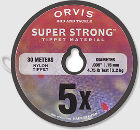Choosing A Fly Rod Size - Start With The Line (1 of 28)
How to choose the right tippet size

Most tippet sizes will support three or four fly sizes before they either get too stiff for a lifelike presentation or too thin to straighten a fly. In general, choose the heavier size if the water is dirty, if it’s windy, or if the fish are unusually strong.
Choose the finer size if the water is very clear and the fish are spooky, or if you are fishing tricky currents and drag is a problem, because a thinner tippet will lessen un-natural drag on your fly.
For average conditions choose the middle size.
| Tippet Size | Tippet Diameter | Approximate breaking strength in Super Strong nylon (pounds) | Balances with fly sizes: |
| 8X | .003" | 1.75 | 22, 24, 26, 28 |
| 7X | .004" | 2.5 | 18, 20, 22, 24 |
| 6X | .004" | 3.5 | 16, 18, 20, 22 |
| 5X | .006" | 4.75 | 14, 16, 18 |
| 4X | .007" | 6 | 12, 14, 16 |
| 3.5 | .008" | 8.5 | 6, 8, 10 |
| 2X | .009" | 11.5 | 4, 6, 8 |
| 1X | .010" | 13.5 | 2, 4, 6 |
| 0X | .011" | 15.5 | 1/0, 2, 4 |
| .012 | .012" | 18.5 | 5/0, 4/0,3/0, 2/0 |
| .013 | .013" | 20 | 5/0, 4/0,3/0, 2/0 |
| .015 | .015" | 25 | 5/0, 4/0,3/0, 2/0 |




